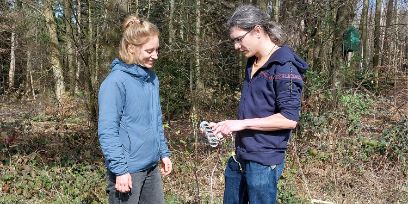- Story
Two worlds, one project, diverse impact
03.05.2024 Christine Moos and Nikita Aigner found each other through the “Junior Scholars Programme: BFH transversal” funding scheme. Their research: for the effective conservation of the Swiss protection forest.
Christine Moos, research associate at BFH, spends a lot of time in nature in both her private life and her job. Outside work, she can often be found enjoying the mountains. She climbs, goes ski touring and passes on her enthusiasm for these kinds of things to her young daughter. Professionally, she is part of the Department of Forest Sciences at BFH-HAFL and specialises in the protective effect of forests against natural hazards.
Nikita Aigner is fascinated by electronics. “I’m currently building my own CNC milling machine and have a few other personal electronics projects on the go at home,” he says. As a research assistant in the Digital Fabrication group at BFH-AHB, his job also lets him live out this fascination. “We support the timber industry with digitalisation projects,” he explains. This ranges from classic automation to IT-related issues in the area of data integration.
BFH offers a valuable opportunity to become established as a Senior Scientist and lead your own projects.

Working together to conserve protected forests
The two researchers met through the “Junior Scholars Programme: BFH transversal”. “This funding scheme assigns you to a cohort where you look for other researchers who are keen to do interdisciplinary research,” Christine Moos sums up. “I contacted Christine and asked if she was interested in sensor technology that can be installed in the forest,” Nikita Aigner continues. His question met with a positive response and a collaboration was born. “We forged the ‘Internet of Soils’ project, got approval from the BFH Research Committee for its implementation, and set to work,” Aigner recalls.
Promotion of interschool research
With the “Junior Scholars Programme: BFH transversal” scheme, Bern University of Applied Sciences BFH supports young researchers who will be collaborating on interschool research projects in the coming years. In this way, BFH promotes interschool careers and makes concrete contributions to socially relevant transformation processes.
Further information on interschool research at BFH can be found here.
A flexible and cost-effective solution
The goal of ‘Internet of Soils’ is to measure soil moisture in protected forests. Nikita Aigner and his team have developed special sensors for this purpose. Sensors already exist that can perform such measurements, he says. “However, we wanted a flexible and cost-effective solution that would make large-scale measurements possible over a longer period of time,” Christine Moos explains. To draw sound conclusions about the forest and its resistance to natural hazards, long-term measurements of soil moisture are an important tool. “With our proprietary solution, we also ensure that the data does not have to be read out from each sensor in the forest, but can be automatically transferred to a database using what is known as long-range technology,” Nikita Aigner concludes.
“As things stand today, the sensors are working,” says Moos. “Now we’re waiting till we have a nice data series to analyse,” she explains. The code for building such sensors will also be made available to the general public in line with the open-source concept. And a follow-up project is already under discussion: “We also want to install the sensors on an area burnt by a forest fire to see how the soil develops in the recovery phase after a fire,” the forest scientist says.
This kind of project is very enriching because it gives you insight into a different field of research.

Greater research complexity
The collaboration between Christine Moos and Nikita Aigner was characterised by regular exchanges, but also involved a clear division of labour. “This kind of project is, of course, very enriching because it gives insight into a different field of research,” Christine Moos stresses. In her case, she was also able to benefit enormously from the development of the sensor for her own research. At the same time, both researchers emphasise that interdisciplinarity also makes the research more complex. “First you have to get a feel for the project,” says Moos. It is also important that both disciplines see opportunities for development. It shouldn’t be the case that one side only contributes and the other only benefits.
Would you also like to work at BFH and get ahead?
Great freedom to organise your work, plenty of room for your own ideas, creativity and decision-making: as an employer, BFH offers a wide range of opportunities.
Further information on BFH as an employer can be found here.
Valuable BFH platforms
One thing’s for sure: both researchers would recommend the “Junior Scholars Programme: BFH transversal” scheme. “Above all, it was cool that the reins of research were largely handed over to the mid-level staff in this programme and that we research associates were able to start our research quickly,” Nikita Aigner concludes. Christine Moos confirms: “Yes, BFH offers a valuable opportunity to become established as a senior scientist and lead your own projects.”

